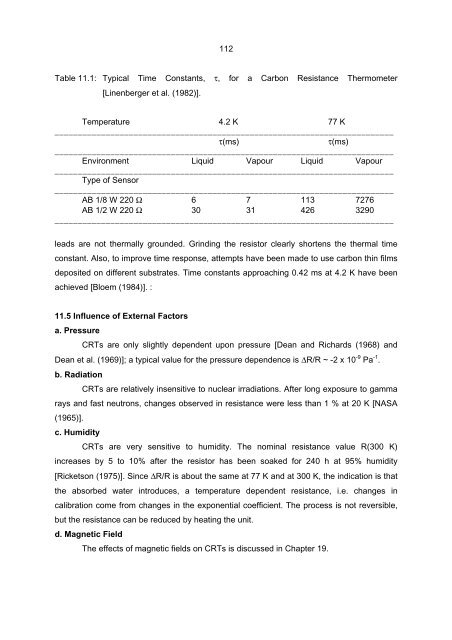techniques for approximating the international temperature ... - BIPM
techniques for approximating the international temperature ... - BIPM
techniques for approximating the international temperature ... - BIPM
You also want an ePaper? Increase the reach of your titles
YUMPU automatically turns print PDFs into web optimized ePapers that Google loves.
112<br />
Table 11.1: Typical Time Constants, τ, <strong>for</strong> a Carbon Resistance Thermometer<br />
[Linenberger et al. (1982)].<br />
Temperature 4.2 K 77 K<br />
_________________________________________________________________________<br />
τ(ms) τ(ms)<br />
_________________________________________________________________________<br />
Environment Liquid Vapour Liquid Vapour<br />
_________________________________________________________________________<br />
Type of Sensor<br />
_________________________________________________________________________<br />
AB 1/8 W 220 Ω 6 7 113 7276<br />
AB 1/2 W 220 Ω 30 31 426 3290<br />
_________________________________________________________________________<br />
leads are not <strong>the</strong>rmally grounded. Grinding <strong>the</strong> resistor clearly shortens <strong>the</strong> <strong>the</strong>rmal time<br />
constant. Also, to improve time response, attempts have been made to use carbon thin films<br />
deposited on different substrates. Time constants approaching 0.42 ms at 4.2 K have been<br />
achieved [Bloem (1984)]. :<br />
11.5 Influence of External Factors<br />
a. Pressure<br />
CRTs are only slightly dependent upon pressure [Dean and Richards (1968) and<br />
Dean et al. (1969)]; a typical value <strong>for</strong> <strong>the</strong> pressure dependence is ∆R/R ~ -2 x 10 -9 Pa -1 .<br />
b. Radiation<br />
CRTs are relatively insensitive to nuclear irradiations. After long exposure to gamma<br />
rays and fast neutrons, changes observed in resistance were less than 1 % at 20 K [NASA<br />
(1965)].<br />
c. Humidity<br />
CRTs are very sensitive to humidity. The nominal resistance value R(300 K)<br />
increases by 5 to 10% after <strong>the</strong> resistor has been soaked <strong>for</strong> 240 h at 95% humidity<br />
[Ricketson (1975)]. Since ∆R/R is about <strong>the</strong> same at 77 K and at 300 K, <strong>the</strong> indication is that<br />
<strong>the</strong> absorbed water introduces, a <strong>temperature</strong> dependent resistance, i.e. changes in<br />
calibration come from changes in <strong>the</strong> exponential coefficient. The process is not reversible,<br />
but <strong>the</strong> resistance can be reduced by heating <strong>the</strong> unit.<br />
d. Magnetic Field<br />
The effects of magnetic fields on CRTs is discussed in Chapter 19.
















